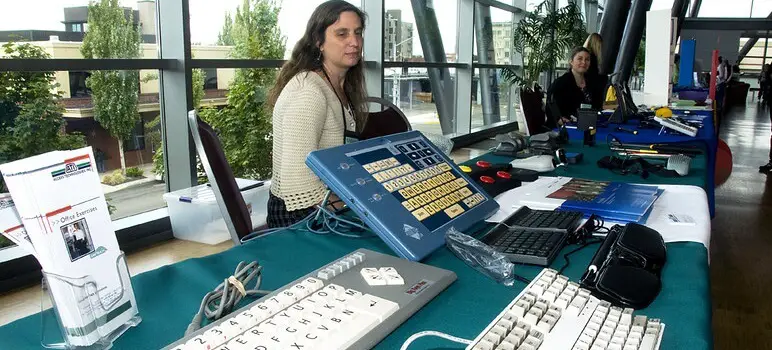The simple definition of disability can be ascribable to an intellectual, psychiatric, cognitive, neurological, sensory or physical impairment or a combination of those impairments. And a person bearing previously mentioned conditions are usually considered as a disabled person.
A disabled person, by no means, is less of a human being and cannot be blamed at all for their conditions. They require special care and attention. And since we consider ourselves as civilized, it is our sacred duty to make people with any impairments to assimilate into society with ease.
And that’s why the necessity for the teachers to learn about Assistive Technologies and Online Learning and make effective implementation in practical use has become so important.
What is Assistive Technology?
Any device, equipment, tool, or software that is designed to make the process of learning and communicating meaningful, objective, and functional can be termed as Assistive Technology. It can also be newly adopted technology or an idea that is implemented to fulfill that goal.
There are several tools in different sizes, shapes, and types to be called Assistive Technology available these days. Assistive technologies can help disabled students integrate with the general curriculum of education effectively. There is also a tuition provider who delivers practical and result-driven assistive special needs tuition for disabled students, and they are well worth looking into.
Comprehensive coverage of some of the Assistive Technologies that are being widely used is provided next:
Assistive Technologies For Visual Impairments
Intel Reader: this text-to-speech mobile device reads printed text aloud.
Braille Embosser: as the name suggests, this device prints Grade 2 Braille on paper, making them visibly disable persons gather and store hard copies of documents.
Duxbury Braille Translation Software: this is software more like a word processor, and it lets the user’s type text and then automatically translate it into Braille.
Talking-Type Software: it’s a typing-teaching program for the blind. It helps them through audio instruction and detailed tutorials.
Braille Note Apex: it’s a PC with a Braille display, and the buttons are raised so the readers can feel them.

Assistive Technologies For Hearing Impairments
Closed Captioning for Videos: this means a text version of the spoken part of a television, movies, or computer presentation. It’s mainly developed for helping with hearing problems but can be used in a variety of situations.
FM Systems: American Speech-Language-Hearing Association deems it to be the most pragmatic choice for people with sensor neural difficulties. It works using radio broadcast technology with a transmitter microphone and a receiver.
Sound-Field Systems: this is a convenient choice for classrooms containing students’ auditory and learning problems like language delays, central sensory processing and articulation disorders, and especially development delays.
Assistive Technologies For Various Impairments
Sip-and-Puff Systems: For people with paralysis and deficient motor skills, Sip-and-Puff systems are a great enabler to learn the fundamental movement patterns
Text-to-Speech: this technology helps the children who face difficulties reading ordinary, standard texts. It is also useful for dyslexia, blindness, autism, and intellectual disability.
Jouse 3: another spin-off from Sip-and-Puff systems that a disable person can control using the mouth, tongue, cheek, chin, etc.
Ginger: it usually helps pupils suffering from dyslexia.
Ghotit: works for people with writing disabilities.
Math Talk: it is a speech and formula are recognizing software. It also has a Braille translator for visual impairment.
There are also a few more ideas and assistive technologies in use that help children with disabilities in various stages:
Graphic Organizer
· JAWS Screen Reader
· Zoom Text Extra Screen–Magnification Software
· Draft-Builder
· Low-Tech Hand-Outs
· Kurzweil 3000
· Proof-reading Software
· Open Book Text Reader
· Sound Sentry
· Instant Messaging
· Math Visuals
· SmartNav 4
Why Should Teachers Embrace Assistive Technology?
With the schools facilitating assistive technologies for the disabled students, the teachers can provide equal opportunity for them to conform to the access to the general curriculum.
As the definition suggests, assistive technologies assist disabled students in revealing themselves with ease. In the absence of the appropriate assistive technology, sometimes simple communications turn out to be draining, fatigued and cumbersome. And when the teachers have already confused and tired people with physical impairments, it gets multiplied by a dozen to teach and make the intended students receive any meaningful instructions.
But with the help of these assistive technologies, teachers can employ different approaches to apprise students differently. So, all the students, able and disabled alike, start receiving teachings equally, which makes the whole class functioning efficiently. Teachers will have more time to look after other students as there will be less aberration, and there will be more time to engage all the students in group activities as well. As a result, the class starts working as a unit, provide required feedback, and there will be a greater motivation for all to move ahead together. This also makes other students more prepared for future reciprocal communication with disabled people.
Most importantly, assistive technology creates an opportunity for teachers to make disabled students participate fully in the learning process. And by joining, the disabled students can help teachers understand how they are coping with their current stage of grasping the topics. And when the teachers have a clear picture, it makes their job so much easier to help the disabled pupils progress smoothly and eventually obtain the degree they were hoping to gain in the first place.
What About Online Learning?
The one thing that human civilization can be proud of is that it was never stagnant. And with each baby steps of growth and development, every conceivable segment of our lives has enjoyed change towards progress. Making our disabled citizens educated also have seen tremendous evolution with the advancement of technological innovations. And quite literally, online education as an assistive technology has been proved a game-changing event in terms of educational opportunities it can provide. A few ways described below how a disabled person can be benefited from online learning when the teachers actively take part in the process:
The convenience of Learning at Your Own Pace, at Your Place
Students with physical impediments find it extremely convenient to get an education through online learning. They no longer have to go through the drudgery of commuting to the place of studies. In a study done by support group Leonard Chesire, it was found that about 90% of disabled children can’t even join the schools for education.
All that is required for the students is to select a course that they think is suitable for them and find teachers who are willing and have sufficient experience to help them to go through.
And in many countries, learning to use assistive technology has been accumulating in the teachers’ training module. So, as the days go by, there will be more experienced teachers who will be willing and be able to help disabled students through the online program by making the best use of all assistive technologies at their disposal.
No Bullies, No Dismays
It’s ugly and straightforward that online learning can provide the disabled students an environment free from social prejudice and discouragements, and eventually lets dread and indisposition wear off. And it provides an ideal situation for the teachers to make the students confident and let them get prepared for the world as best they possibly can.
Encourages Resiliency and Wonderment
The adage “curiosity can kill the cat” now becomes “it can also help the cat become a better hunter.” Proper guidance provided by the teachers can help disabled students develop the attitude needed for thriving in the beautiful world of study, research, and learning. And in return, they will be suitably adept at moving along effortlessly in this complex modern world.
Availability of Study Materials
A convenient feature of online learning is that to collect all the necessary study materials, you need a stable internet collection. When the teachers work in tandem with the students, the workload of studies become more manageable and fun to proceed, because the teachers can point to the right way early on in numerous ways, like a teacher can suggest the name of a writer best for a particular topic and if it’s available in the required forms suitable for disabled students.
I can keep pointing out more promising points offered by online learning for the physically impaired students, but let me finish saying that, once what was a fickle dream now becomes a reality waiting for happening, just after a few clicks away.
So, it’s evident that by embracing all the Assistive Teaching technologies available out there for the disabled population and making online learning more accessible and pragmatic for them, the teachers can truly make our community the real wealth of our nation.


